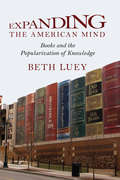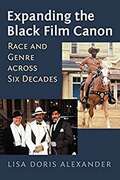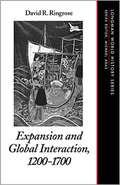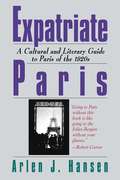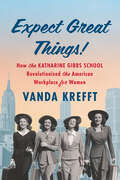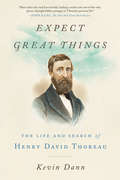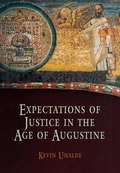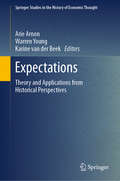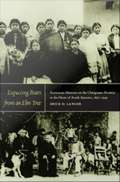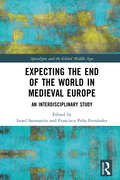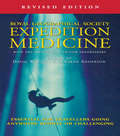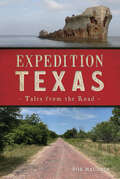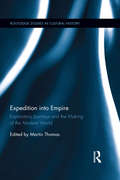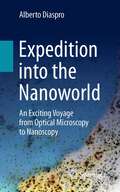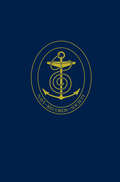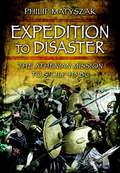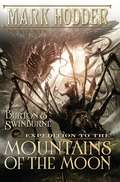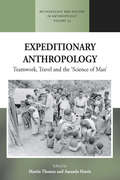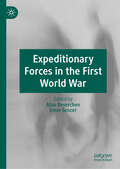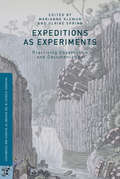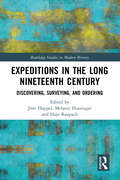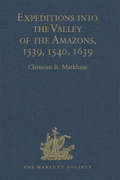- Table View
- List View
Expanding the American Mind: Books and the Popularization of Knowledge
by Beth LueyOver the past fifty years, knowledge of the natural world, history, and human behavior has expanded dramatically. What has been learned in the academy has become part of political discourse, sermons, and everyday conversation. The dominant medium for transferring knowledge from universities to the public is popularization--books of serious nonfiction that make complex ideas and information accessible to nonexperts. Such writers as Carl Sagan, Stephen Jay Gould, Stephen Hawking, Daniel Boorstin, and Robert Coles have attracted hundreds of thousands of readers. As fields such as biology, physics, history, and psychology have changed the ways we view ourselves and our place in the universe, popularization has played an essential role in helping us to understand our world. Expanding the American Mind begins by comparing fiction and nonfiction--their relative respectability in the eyes of reading experts and in the opinions of readers themselves. It then traces the roots of popularization from the Middle Ages to the present, examining changes in literacy, education, and university politics. Focusing on the period since World War II, it examines the ways that curricular reform has increased interest in popularization as well as the impact of specialization and professionalization among the faculty. It looks at the motivations of academic authors and the risks and rewards that come from writing for a popular audience. It also explains how experts write for nonexperts--the rhetorical devices they use and the voices in which they communicate. Beth Luey also looks at the readers of popularizations--their motivations for reading, the ways they evaluate nonfiction, and how they choose what to read. This is the first book to use surveys and online reader responses to study nonfiction reading. It also compares the experience of reading serious nonfiction with that of reading other genres. Using publishers' archives and editor-author correspondence, Luey goes on to examine what editors, designers, and marketers in this very competitive business do to create and sell popularizations to the largest audience possible. In a brief afterword she discusses popularization and the Web. The result is a highly readable and engaging survey of this distinctive genre of writing.
Expanding the Black Film Canon: Race and Genre Across Six Decades
by Lisa Doris AlexanderIf the sheer diversity of recent hits from Twelve Years a Slave and Moonlight to Get Out, Black Panther, and BlackkKlansman tells us anything, it might be that there’s no such thing as “black film” per se. This book is especially timely, then, in expanding our idea of what black films are and, going back to the 1960s, showing us new and interesting ways to understand them. <p><p> When critics and scholars write about films from the Blaxploitation movement—such as Cotton Comes to Harlem, Shaft, Superfly, and Cleopatra Jones—they emphasize their importance as films made for black audiences. Consequently, Lisa Doris Alexander points out, a film like the highly popular, Oscar-nominated Blazing Saddles—costarring and co-written by Richard Pryor—is generally left out of the discussion because it doesn’t fit the profile of what a black film of the period should be. This is the kind of categorical thinking that Alexander seeks to broaden, looking at films from the 60s to the present day in the context of their time. Applying insights from black feminist thought and critical race theory to one film per decade, she analyzes what each can tell us about the status of black people and race relations in the United States at the time of its release. <p><p> By teasing out the importance of certain films excluded from the black film canon, Alexander hopes to expand that canon to include films typically relegated to the category of popular entertainment—and to show how these offer more nuanced representations of black characters even as they confront, negate, or parody the controlling images that have defined black filmic characters for decades.
Expanding the Palace of Torah: Orthodoxy and Feminism
by Tamar Ross"Expanding the Palace of Torah offers a broad philosophical overview of the challenges the women's revolution poses to Orthodox Judaism, and Orthodox Judiasm's response to those challenges. Writing as an insider (herself an Orthodox Jew), Ross seeks to develop a theological response that fully acknowledges the male bias of Judaism's sanctified texts, yet nevertheless provides a rational for transforming that bias in today's world without undermining their authority. She proposes an approach to divine revelation-- the theological heart of traditional Judaism-- which she calls "cumulativism." This approach is based on a conflating of strict boundaries between text and its interpretation, or the divine intent and the evolution of human understanding." "Ross believes that the greater fluidity afforded by cumulativism is necessary for legitimizing the insights of feminism and fully absorbing women's changed status within the religious rubric of Jewish tradition. Emphasizing that continuity with tradition can be maintained only when the halakhic system is understood as a living organism that grows via affirmation of its historical legacy and respect for its constraints, her book shows that the feminist revolution in Orthodox Judaism reaches beyond its practical effect upon individual lives to teach us something more profound about the nature of religious practice in general." -- Amy Gottlieb Zorn berg (from the back cover)
Expansion And Global Interaction: 1200-1700
by David R. RingroseA new entry in the Longman World History Series, this volume is a perfect supplement to a World History or Western Civilization course as well as introductory courses on Asia, Africa, or Latin America. Each book in the Longman World History Series, edited by Michael Adas, focuses on a prominent theme, process, or pattern in global history, and treats the topic in a cross-cultural and comparative manner. In Expansion and Global Interaction: 1200-1700, David Ringrose, an established historian of Spain and the Spanish empire, explores the dynamism that arose everywhere in the world after 1200 and shows how a series of autonomous societies became interdependent on a global scale by 1700. By examining the five major arenas of conflict, ranging from Imperial China to the Aztec and Inca Empires, he illustrates how political, cultural, and economic zones of influence expanded and overlapped. The author concludes with the observation that, by 1700, Europeans were influential across the globe, but were not yet dominant in more than a few areas and, as of 1700, their power in the nineteenth century would have been hard to predict.
Expatriate Paris: A Cultural and Literary Guide to Paris of the 1920s
by Arlen J. HansenParis has long been a storied center of art and culture, and of romance, but in the 1920s its magnetism was especially irresistible. From around the world writers, artists, and composers steamed in, to visit or linger, some to reside. For travelers, Francophiles and the curious, this gossipy retrospective of expatriate life in Paris in the 1920s is a mosaic of quick glimpses--Sarah Bernhardt sleeping in a coffin to overcome her fear of death, Igor Stravinsky diving through a huge wreath at the premiere of his ballet Les Noces, Ford Madox Ford meeting Ernest Hemingway, Langston Hughes near starvation, Josephine Baker establishing her nightclub. The list of expatriates is long and luminous, and this book--a work of immense erudition spiced with anecdotes and gossip--documents their haunts and habits, their comings and goings, their relationships intimate and artistic. Structured in thirty-three geographical and very walkable sections, Expatriate Paris is cross-referenced by streets, names, and topics and equipped with nine maps to satisfy the most demanding traveler, whether real or armchair.
Expats and The Labor Force
by George Naufal Ismail GencExpats and the Labor Force examines the flows of people and money in the Gulf Cooperation Council (GCC) countries. This timely book outlines the reasons that made the Gulf region a destination for millions of migrants. Taking advantage of the discovery of large hydrocarbon reserves and relatively stable political environment, the GCC countries filled the large demand for labor with foreign workers. However the number, share, and source of expatriates have presented serious challenges for the region. Naufal and Genc discuss these consequences on the composition of the labor force and remittance outflows.
Expect Great Things!: How the Katharine Gibbs School Revolutionized the American Workplace for Women
by Vanda KrefftA fun and fascinating social history of the famed Katharine Gibbs School, which from the 1910s to the 1960s, trained women for executive secretary positions but surreptitiously was instilling the self-confidence and strategic know-how necessary for them to claim equality, power, and authority in the wider world. It&’s a safe bet that most of the secretaries on the TV series Mad Men would have attended the Katharine Gibbs School in New York City. The iconic institution was in its heyday in the 1950 and '60s synonymous with supplying secretaries—always properly attired in heels, ladylike hats, and white gloves—to male executives. In Expect Great Things! Vanda Krefft turns the notion of a &“Gibbs girl&” on its head, showing us that while the school was getting women who could type 90 words per minute into the C-suite, its more subversive mission was to get them out of the secretarial pool to assume positions of power on the other side of the desk. And Gibbs graduates did just that, tackling the sexism of the era and paving the way for 21st-century women to succeed in any profession. Katharine Gibbs was one her own success stories. She started her school when, as a 46-year-old widow, she was left near-broke with two young sons. The school taught typing and stenography but Gibbs also hired accomplished professors from elite colleges to teach academic subjects—it was a well-rounded education that produced early feminists ready to tackle the sexism of their era. "Expect great things!" was her motto and her philosophy. Within a decade she&’d opened schools in three elegant locations. With nostalgic period photographs throughout, Expect Great Things! takes us back to Katie Gibbs&’s life and tells the stories of the women she influenced. We meet Gibbs graduates who worked for the Walt Disney, Marilyn Monroe, and Robert F. Kennedy. Others forged pathfinding roles as an Emmy-winning television star, a women&’s rights advisor to four U.S. presidents, a writer of Wonder Woman comic books, the head of the Women&’s Marines, a best-selling young adult author, and a U.S. Ambassador. For readers of The Barbizon and Come Fly the World, Expect Great Things! reveals the seismic impact the Katharine Gibbs school had on the American workplace—and on women&’s opportunities today.
Expect Great Things: The Life and Search of Henry David Thoreau
by Kevin DannTo coincide with the bicentennial of Thoreau's birth in 2017, this thrilling, meticulous biography by naturalist and historian Kevin Dann fills a gap in our understanding of one modern history's most important spiritual visionaries by capturing the full arc of Thoreau's life as a mystic, spiritual seeker, and explorer in transcendental realms.This sweeping, epic biography of Henry David Thoreau sees Thoreau's world as the mystic himself saw it: filled with wonder and mystery; Native American myths and lore; wood sylphs, nature spirits, and fairies; battles between good and evil; and heroic struggles to live as a natural being in an increasingly synthetic world. Above all, Expect Great Things critically and authoritatively captures Thoreau's simultaneously wild and intellectually keen sense of the mystical, mythical, and supernatural. Other historians have skipped past or undervalued these aspects of Thoreau's life. In this groundbreaking work, historian and naturalist Kevin Dann restores Thoreau's esoteric visions and explorations to their rightful place as keystones of the man himself.
Expectations of Justice in the Age of Augustine
by Kevin UhaldeAugustine, bishop of Hippo between 395 and 430, and his fellow bishops lived and worked through massive shifts in politics, society, and religion. Christian bishops were frequently asked to serve as intellectuals, legislators, judges, and pastors--roles and responsibilities that often conflicted with one another and made it difficult for bishops to be effective leaders. Expectations of Justice in the Age of Augustine examines these roles and the ways bishops struggled to fulfill (or failed to fulfill) them, as well as the philosophical conclusions they drew from their experience in everyday affairs, such as oath-swearing, and in the administration of penance.Augustine and his near contemporaries were no more or less successful at handling the administration of justice than other late antique or early medieval officials. When bishops served in judicial capacities, they experienced firsthand the complex inner workings of legal procedures and social conflicts, as well as the fallibility of human communities. Bishops represented divine justice while simultaneously engaging in and even presiding over the sorts of activities that animated society--business deals, litigations, gossip, and violence--but also made justice hard to come by.Kevin Uhalde argues that serving as judges, even informally, compelled bishops to question whether anyone could be guaranteed justice on earth, even from the leaders of the Christian church. As a result, their ideals of divine justice fundamentally changed in order to accommodate the unpleasant reality of worldly justice and its failings. This philosophical shift resonated in Christian thought and life for centuries afterward and directly affected religious life, from the performance of penance to the way people conceived of the Final Judgment.
Expectations: Theory and Applications from Historical Perspectives (Springer Studies in the History of Economic Thought #Vol. 65)
by Arie Arnon Warren Young Karine van der BeekThis book provides a unique historical perspective on expectations in economic theory, and applications of expectations models in economic history. Based on papers presented at the 2017 Thomas Guggenheim Conference, it brings together the work of economists, historians of economics, and economic historians on issues and events concerning expectations in economics and economic history. The contributions address: (i) the history of expectations models; (ii) growth, expectations and political economy; (iii) controversies regarding expectations methods and models; (iv) expectations in theory and reality; and (v) expectations in economic history. The book opens with a lecture by Thomas Guggenheim Prize winner Duncan Foley on the evolution of expectations in modern economic thought. The remaining content is divided into two parts, the first of which focuses on the utilization of expectations in the “ancient” and “meso” periods of high theory, i.e., from Smithian to Keynesian approaches. The papers cover topics such as “modern” applications of expectations in both “Tobinesque-Phillips” and “Harrodian-Solowian” contexts, and the debate between Friedmanite and Keynesian approaches to expectation formation. In turn, the last part presents essays on the role of economic expectations in connection with historical events and contexts, ranging from the early 20th century to World War II, and on the application of expectations theory to hyperinflation and stabilization, taking Israel as a case study.
Expecting Pears from an Elm Tree: Franciscan Missions on the Chiriguano Frontier in the Heart of South America, 1830-1949
by Erick D. LangerMissions played a vital role in frontier development in Latin America throughout the nineteenth and twentieth centuries. They were key to the penetration of national societies into the regions and indigenous lands that the nascent republics claimed as their jurisdictions. In Expecting Pears from an Elm Tree, Erick D. Langer examines one of the most important Catholic mission systems in republican-era Latin America, the Franciscan missions among the Chiriguano Indians in southeastern Bolivia. Using that mission system as a model for understanding the relationship between indigenous peoples and missionaries in the post-independence period, Langer explains how the missions changed over their lifespan and how power shifted between indigenous leaders and the missionaries in an ongoing process of negotiation. Expecting Pears from an Elm Tree is based on twenty years of research, including visits to the sites of nearly every mission discussed and interviews with descendants of mission Indians, Indian chiefs, Franciscan friars, mestizo settlers, and teachers. Langer chronicles how, beginning in the 1840s, the establishment of missions fundamentally changed the relationship between the Chiriguano villages and national society. He looks at the Franciscan missionaries' motives, their visions of ideal missions, and the realities they faced. He also examines mission life from the Chiriguano point of view, considering their reasons for joining missions and their resistance to conversion, as well as the interrelated issues of Indian acculturation and the development of the mission economy, particularly in light of the relatively high rates of Indian mortality and outmigration. Expanding his focus, Langer delves into the complex interplay of Indians, missionaries, frontier society, and the national government until the last remaining missions were secularized in 1949. He concludes with a comparative analysis between colonial and republican-era missions throughout Latin America.
Expecting the End of the World in Medieval Europe: An Interdisciplinary Study (Apocalypse and the Global Middle Ages)
by Israel Sanmartín Francisco Peña FernándezExpecting the End of the World in Medieval Europe: An Interdisciplinary Study examines the phenomenon of medieval eschatology from a global perspective, both geographically and intellectually. The collected contributions analyze texts, authors, social movements, and cultural representations covering a wide period, from the 6th to the 16th century, in geographically liminal spaces where Catholic, Byzantine, Islamic, and Jewish cultures converged.The book is organized in eleven chapters which reflect and explore the following arguments: the study of specific eschatological episodes in medieval Europe and their interpretations; the analysis of apocalyptic visionaries, apocalyptic authors, and their individual contributions; the social and political implications of eschatology in medieval society; the study of medieval apocalyptic literature from a rhetorical, narratological, and historiographical perspective; the history of the transmission of apocalyptic literature and its transformation over time; and a comparative examination of apocalypticism between the Middle Ages and the Early Modern era.This study provides a lens through which academics, specialists, and interested researchers can observe and reflect on this entire eschatological universe, dwelling both on well-known texts, authors, and events, and on others which are much less popular. In gathering different paradigms, tools, and theoretical frameworks, the book exposes readers to the complex reality of medieval anxiety regarding the end of the world.
Expedition Medicine: Revised Edition (Oxford Medical Handbooks Ser.)
by Sarah Anderson David WarrellThis is a completely rewritten and revised second edition of the now standard text, prepared under the auspices of the Royal Geographical Society of Great Britain. Comprehensively updated to take into account new research findings and medicines, and adapted for the American explorer, Expedition Medicine is written by renowned experts in their fields and provides a wealth of practical tips and advice, as well as extensive details about first aid kits, emergency procedures, and evacuation routines. Coverage includes sections on every kind of travel from desert to mountain, canoeing to diving, and off-road driving to walking, with valuable information on vaccinations, medicines, and hygiene.
Expedition Texas: Tales from the Road (The\history Press Ser.)
by Bob MauldinIf the weathered landmarks and forgotten trails of the Lone Star State could talk, this is what they might say.The TV show Expedition Texas brings to life stories of abandoned buildings, ghost towns and other lost Texas history locations. Hit the road with Bob Mauldin and his crew and hear the stories behind the stories. Venture deep beneath the surface to explore a missile launch site. Climb crumbling stairs high above the ground to the top of amazing historical hotels. There's lost history all over Texas. And, on Expedition Texas, we're gonna find it.
Expedition into Empire: Exploratory Journeys and the Making of the Modern World (Routledge Studies in Cultural History #31)
by Martin ThomasExpeditionary journeys have shaped our world, but the expedition as a cultural form is rarely scrutinized. This book is the first major investigation of the conventions and social practices embedded in team-based exploration. In probing the politics of expedition making, this volume is itself a pioneering journey through the cultures of empire. With contributions from established and emerging scholars, Expedition into Empire plots the rise and transformation of expeditionary journeys from the eighteenth century until the present. Conceived as a series of spotlights on imperial travel and colonial expansion, it roves widely: from the metropolitan centers to the ends of the earth. This collection is both rigorous and accessible, containing lively case studies from writers long immersed in exploration, travel literature, and the dynamics of cross-cultural encounter.
Expedition into the Nanoworld: An Exciting Voyage from Optical Microscopy to Nanoscopy
by Alberto DiasproThe story of microscopy over the years is one of wonder, revelation, and even love. What better words could there be to describe the amazing things that we have been able to see, learn and accomplish thanks to the progress made in this field? A love story between a pieace of glass and the rainbow with an original soundtrack mad of poetry and music. From Galilei’s initial foray into basic optical microscopy, including the Camillo Golgi and Giuliano Toraldo di Francia lessons, to such later developments as time-resolved microscopy, multi-photon microscopy and three-dimensional microscopy to innovations such as optical nanoscopy, bioimaging and super resolution imaging, the book seeks to take the reader, be they scientist or layperson, on a journey through the evolution of the microscope and its many uses, including in the field of medicine. The author uses visible light as a through-line to unite the various chapters, as well as using fluorescence as a touchpoint from which to map the changes in the science, a significant choice, as it, along with label-free approaches and the addition of artificial intelligence, form the natural environment for development of the modern multi-messenger microscope towards bioimaging at the nanoscale.
Expedition of Sir John Norris and Sir Francis Drake to Spain and Portugal, 1589
by R.B. WernhamActions against the Spanish Armada and campaigns in the Netherlands left the Queen’s coffers empty. For this reason proposals to capture the Spanish treasure fleet were given royal support. The treasure fleet homeward bound from the Americas would be intercepted in the Azores. A diversion at Santander to damage the Spanish fleet would prevent protection of the treasure fleet and, more importantly, prevent further actions against England or Ireland. However, the project was diverted further with backers wanting to re-instate Don Antonio as King of Portugal, with ideas of gaining lucrative Portuguese trade rights.At sea a further diversion was taken, with news of shipping at Corunna and the prospect of capturing merchantmen. ‘Profit was already challenging strategy’. This diversion gave their enemies more time to prepare. The failure at Lisbon was partly from a lack of co-ordination between the navy and army but also from the lack of promised support from Don Antonio’s supporters.The decision to sail for the Azores to intercept the Spanish treasure fleet was at last made only for Drake to be driven back to England by a storm. Short of supplies and with sick crews the ships were in no condition to continue with the Queen’s demands so there was no great treasure and the Spanish fleet was still in being. The sale of prizes and their contents failed to cover the cost of the expedition, and so the expedition was considered a financial and strategic failure.
Expedition to Disaster: The Athenian Mission to Sicily 415 BC
by Philip MatyszakThis thrillingly vivid history recounts a pivotal battle of the Peloponnesian War, bringing the drama and personalities of the Sicilian Expedition to life. The Athenian expedition to conquer Sicily was one of the most significant military events of the classical period. At the time, Athens was locked in a decades-long struggle with Sparta for mastery of the Greek world. The expedition to Sicily was intended to win Athens the extra money and resources needed to crush the Spartans. With the aid of new archaeological discoveries, Expedition to Disaster reconstructs the mission, and the ensuing siege, in greater detail than ever before. The cast of characters includes Alcibiades, the flamboyant, charismatic young aristocrat; Nicias, the ageing, reluctant commander of the ill-fated expedition, and Gylippus, the grim Spartan general sent to command the defense of Syracuse. It was he who turned the tables on the Athenian invaders. They were surrounded, besieged, and forced to ask for mercy from a man who had none. Philip Matyszak's combination of thorough research and gripping narrative presents an episode of ancient history packed with colorful characters and dramatic tension.
Expedition to the Mountains of the Moon (A Burton & Swinburne Adventure #3)
by Mark HodderIt is 1863, but not the one it should be. Time has veered wildly off course, and now the first moves are being made that will lead to a devastating world war and the fall of the British Empire. Caught in a tangled web of cause, effect, and inevitability, little does Burton realize that the stakes are far higher than even he suspects. A final confrontation comes in the mist-shrouded Mountains of the Moon, in war- torn Africa of 1914, and in Green Park, London, where, in the year 1840, Burton must face the man responsible for altering time: Spring Heeled Jack! Burton and Swinburne's third adventure is filled with eccentric steam-driven technology, grotesque characters, and bizarre events, completing the three-volume story arc begun in The Strange Affair of Spring Heeled Jack and The Curious Case of the Clockwork Man.
Expeditionary Anthropology: Teamwork, Travel and the ''Science of Man'' (Methodology & History in Anthropology #33)
by Martin Thomas Amanda HarrisThe origins of anthropology lie in expeditionary journeys. But since the rise of immersive fieldwork, usually by a sole investigator, the older tradition of team-based social research has been largely eclipsed. Expeditionary Anthropology argues that expeditions have much to tell us about anthropologists and the people they studied. The book charts the diversity of anthropological expeditions and analyzes the often passionate arguments they provoked. Drawing on recent developments in gender studies, indigenous studies, and the history of science, the book argues that even today, the ‘science of man’ is deeply inscribed by its connections with expeditionary travel.
Expeditionary Forces in the First World War
by Emre Sencer Alan BeyerchenWhen war engulfed Europe in 1914, the conflict quickly took on global dimensions. Although fighting erupted in Africa and Asia, the Great War primarily pulled troops from around the world into Europe and the Ottoman Empire. Amid the fighting were large numbers of expeditionary forces—and yet they have remained largely unstudied as a collective phenomenon, along with the term “expeditionary force” itself. This collection examines the expeditionary experience through a wide range of case studies. They cover major themes such as the recruitment, transport, and supply of far-flung troops; the cultural and linguistic dissonance, as well as gender relations, navigated by soldiers in foreign lands; the political challenge of providing a rationale to justify their dislocation and sacrifice; and the role of memory and memorialization. Together, these essays open up new avenues for understanding the experiences of soldiers who fought the First World War far from home.
Expeditions as Experiments
by Marianne Klemun Ulrike SpringThis collection focuses on different expeditions and their role in the process of knowledge acquisition from the eighteenth century onwards. It investigates various forms of scientific practice conducted during, after and before expeditions, and it places this discussion into the scientific context of experiments. In treating expeditions as experiments in a heuristic sense, we also propose that the expedition is a variation on the laboratory in which different practices can be conducted and where the transformation of uncertain into certain knowledge is tested. The experimental positioning of the expedition brings together an ensemble of techniques, strategies, material agents and social actors, and illuminates the steps leading from observation to facts and documentation. The chapters show the variety of scientific interests that motivated expeditions with their focus on natural history, geology, ichthyology, botany, zoology, helminthology, speleology, physical anthropology, oceanography, meteorology and magnetism.
Expeditions in the Americas, 1492-1700
by Stephen CurrieExplains why Europeans were interested in the Indies during the 1400s and 1500s. Describes Columbus' journey to the Western Hemisphere and explains how he was mistaken in thinking that he had reached the Spice Islands. Identifies parts of a caravel and carrack. Compares and contrasts European and Native American views on Cortés' invasion of Mexico. Traces La Salle's journey down the Mississippi River.
Expeditions in the Long Nineteenth Century: Discovering, Surveying, and Ordering (Routledge Studies in Modern History)
by Jörn Happel Melanie Hussinger Hajo RaupachThis book examines the processes of scientific, cultural, political, technical, colonial and violent appropriation during the 19th century. The 19th century was the century of world travel. The earth was explored, surveyed, described, illustrated, and categorized. Travelogues became world bestsellers. Modern technology accompanied the travelers and adventurers: clocks, a postal and telegraph system, surveying equipment, and cameras. The world grew together faster and faster. Previously unknown places became better known: the highest peaks, the coldest spots, the hottest deserts, and the most remote cities. Knowledge about the white spots of the earth was systematically collected. Those who made a name for themselves in the 19th century are still read today. Alexander von Humboldt or Charles Darwin made the epoch a scientific heyday. Ida Pfeiffer or Isabelle Bird (Bishop) traveled to distant continents and took their readers at home on insightful journeys. Hermann Vámbéry or Sir Richard Burton got to know the most remote languages and regions. There are countless travel reports about a fascinating century, which, with surveying and exploration, also brought colonial conquest and exploitation into the world. In ten individual studies, the authors explore travelers from all over the world and analyze their successes. The unifying element of all the studies is the experience of distance and its communication by means of travelogues to the armchair travelers who have stayed at home.This volume will be of value to students and scholars both interested in modern history, social and cultural history, and the history of science and technology.
Expeditions into the Valley of the Amazons, 1539, 1540, 1639 (Hakluyt Society, First Series #24)
by Clements R. MarkhamIncludes the following accounts: Expedition of Gonzalo Pizarro to the land of Cinnamon, A.D. 1539-42, translated from the 2d pt. of Garcilasso Inca de la Vega's 'Royal commentaries of Peru'; The voyage of Francisco de Orellana down the river of the Amazons, A.D. 1540-1, translated from the sixth decade of A. de Herrera's 'General history of the western Indies'; New discovery of the great river of the Amazons, by 'Father Cristóbal de Acuña, A.D. 1639, translated from the Spanish edition of 1641. With a 'List of the Principal Tribes of the Valley of the Amazons'. Translated and Edited, with Notes. The supplementary material includes the 1859 annual report. This is a new print-on-demand hardback edition of the volume first published in 1859.
